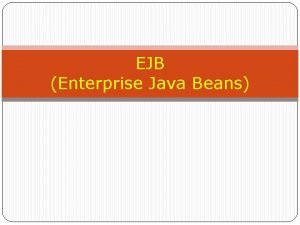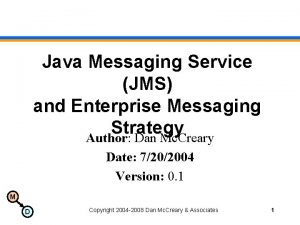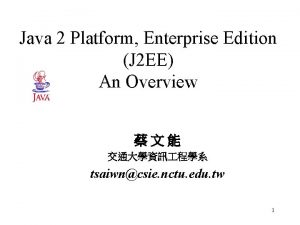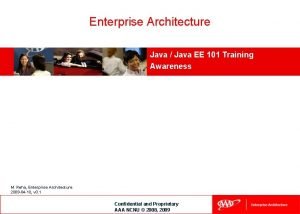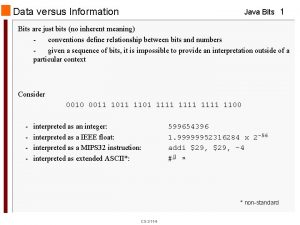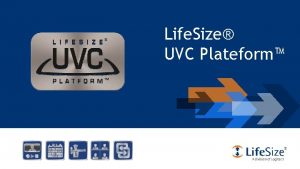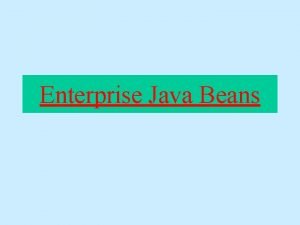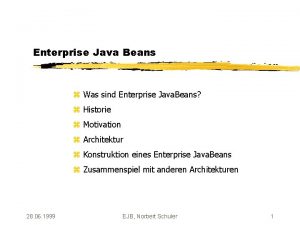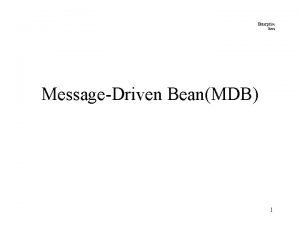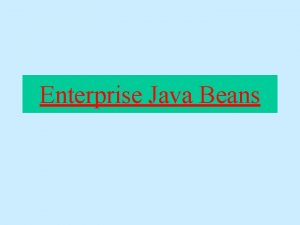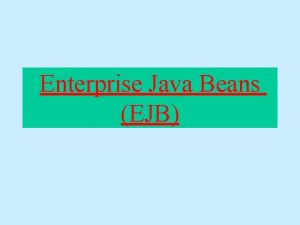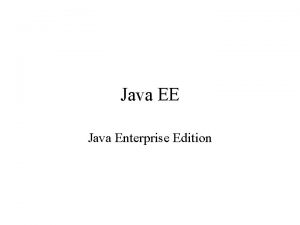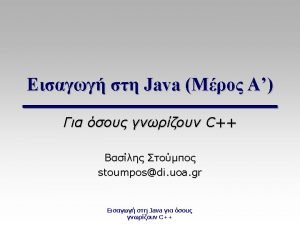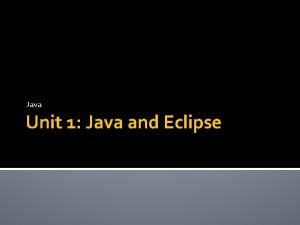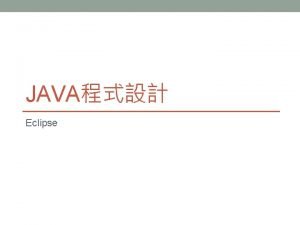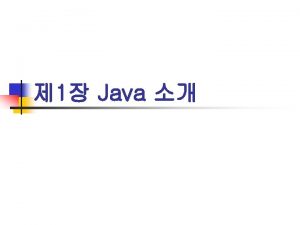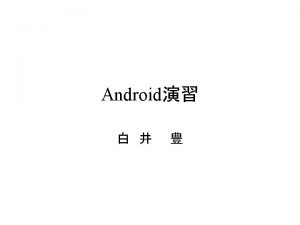Plateform for Enterprise Solution Java EE 5 1



































- Slides: 35

Plateform for Enterprise Solution: Java EE 5 1

Platform for Enterprise Solutions : JAVA EE 5: What is Java EE ? JEE is actually a collection of technologies and APIs for the Java platform designed to support "Enterprise" Applications which can generally be classed as large-scale, distributed, transactional and highly-available applications designed to support mission-critical business requirements. In terms of what an employee is looking for in specific techs, it is quite hard to say, because the playing field has kept changing over the last five years. It really is about the class of problems that are being solved more than anything else. Transactions and distribution are key. 2

JAVA EE Platform Overview The Java EE platform is a set of standard specifications that describe application components, APIs, and the runtime containers and services of an application server. Java Platform, Enterprise Edition (Java EE) is the standard in communitydriven enterprise software. Java EE is developed using the Java Community Process, with contributions from industry experts, commercial and open source organizations, Java User Groups, and countless individuals. Each release integrates new features that align with industry needs, improves application portability, and increases developer productivity. Today, Java EE offers a rich enterprise software platform, and with over 20 compliant Java EE implementations to choose from, low risk and plenty of options. 3

Web core technologies: Servlets and JSP What is the difference between JSF, Servlet and JSP ? Servlet JSP is html in java is java in html 5

Java Server Faces (JSF) 6

Java Server Faces (JSF) is a Java-based web application framework intended to simplify development integration of web-based user interfaces. Java Server Faces is a standardized display technology which was formalized in a specification through the Java Community Process. 7

What is JSF? JSF is a MVC web framework that simplifies the construction of user interfaces (UI) for server-based applications by using reusable UI components in a page. JSF provides facility to connect UI widgets with data sources and to server -side event handlers. The JSF specification defines a set of standard UI components and provides an Application Programming Interface (API) for developing components. JSF enables the reuse and extension of the existing standard UI components. 8

JSF Benefits providing making easy data transfer between UI components managing enabling wiring reusable UI components UI state across multiple server requests implementation of custom components client side event to server side application code 9

JSF UI component model Core library A set of base UI components - standard HTML input elements Extension of the base UI components to create additional UI component libraries or to extend existing components. Multiple rendering capabilities that enable JSF UI components to render themselves differently depending on the client types 10

What is MVC Design Pattern? Module Description Model Carries Data and login View Shows User Interface Controller Handles processing of an application 11

JSF Architecture 12

JSF - Life Cycle 13

Servlets 14

Servlets provide a component-based, platformindependent method for building Web-based applications, without the performance limitations of CGI programs. Servlets have access to the entire family of Java APIs, including the JDBC API to access enterprise databases. 15

What are Servlets? Java Servlets are programs that run on a Web or Application server and act as a middle layer between a request coming from a Web browser or other HTTP client and databases or applications on the HTTP server. Using Servlets, we can collect input from users through web page forms, present records from a database or another source, and create web pages dynamically. 16

Servlets advantages in comparison with the CGI Performance is significantly better. Servlets execute within the address space of a Web server. It is not necessary to create a separate process to handle each client request. Servlets are platform-independent because they are written in Java security manager on the server enforces a set of restrictions to protect the resources on a server machine. So servlets are trusted. The full functionality of the Java class libraries is available to a servlet. It can communicate with applets, databases, or other software via the sockets and RMI mechanisms that you have seen already. 17

Servlets Architecture 18

Servlets Tasks Read the explicit data sent by the clients (browsers). This includes an HTML form on a Web page or it could also come from an applet or a custom HTTP client program. Read the implicit HTTP request data sent by the clients (browsers). This includes cookies, media types and compression schemes the browser understands, and so forth. Process the data and generate the results. This process may require talking to a database, executing an RMI or CORBA call, invoking a Web service, or computing the response directly. Send the explicit data (i. e. , the document) to the clients (browsers). This document can be sent in a variety of formats, including text (HTML or XML), binary (GIF images), Excel, etc. Send the implicit HTTP response to the clients (browsers). This includes telling the browsers or other clients what type of document is being returned (e. g. , 19 HTML), setting cookies and caching parameters, and other such tasks.

Servlets Packages Java Servlets are Java classes run by a web server that has an interpreter that supports the Java Servlet specification. Servlets can be created using the javax. servlet and javax. servlet. http packages, which are a standard part of the Java's enterprise edition, an expanded version of the Java class library that supports large-scale development projects. 20

Servlet Development environment setup Setting up Java Development Kit 21

Servlet life cycle It is initialized by calling the init () method. It calls service() method to process a client's request. It is terminated by calling the destroy() method. Finally, it is garbage collected by the garbage collector of the JVM. 22

Architecture Diagram 23

Servlets Form Data File Uploading Client Request Handling Date Server Response Page Redirect Http Codes Hits Counter Writing Filters Auto Refresh Exceptions Sending Email Cookies Handling Packaging Session Tracking Debugging Database Access Internationalization 24

JSP 25

JSP Java Server Pages (JSP) is a server-side programming technology that enables the creation of dynamic, platform-independent method for building Web-based applications. JSP have access to the entire family of Java APIs, including the JDBC API to access enterprise databases. 26

What is Java Server Pages? Java Server Pages (JSP) is a technology for developing web pages that support dynamic content which helps developers insert java code in HTML pages by making use of special JSP tags, most of which start with <% and end with %>. A Java Server Pages component is a type of Java servlet that is designed to fulfill the role of a user interface for a Java web application. 27

Why Use JSP? Performance is significantly better because JSP allows embedding Dynamic Elements in HTML Pages itself instead of having a separate CGI files. JSP are always compiled before it's processed by the server unlike CGI/Perl which requires the server to load an interpreter and the target script each time the page is requested. Java Server Pages are built on top of the Java Servlets API, so like Servlets, JSP also has access to all the powerful Enterprise Java APIs, including JDBC, JNDI, EJB, JAXP etc. JSP pages can be used in combination with servlets that handle the business logic, the model supported by Java servlet template engines. 28

Advantages of JSP vs. Active Server Pages (ASP): The advantages of JSP are twofold. First, the dynamic part is written in Java, not Visual Basic or other MS specific language, so it is more powerful and easier to use. Second, it is portable to other operating systems and non-Microsoft Web servers. vs. Pure Servlets: It is more convenient to write (and to modify!) regular HTML than to have plenty of println statements that generate the HTML. 29

Advantages of JSP vs. Server-Side Includes (SSI): SSI is really only intended for simple inclusions, not for "real" programs that use form data, make database connections, and the like. vs. Java. Script: Java. Script can generate HTML dynamically on the client but can hardly interact with the web server to perform complex tasks like database access and image processing etc. vs. Static HTML: Regular HTML, of course, cannot contain dynamic information. 30

JSP - Architecture 31

JSP Processing 32

JSP - Life Cycle Compilation Initialization Execution Cleanup 33

JSP - Life Cycle 34

JSP Compilation The compilation process involves three steps: Parsing the JSP. Turning the JSP into a servlet. Compiling the servlet. 35

JSF, Servlet and JSP is a webpage scripting language that can generate dynamic content while Servlets are Java programs that are already compiled which also creates dynamic web content Servlets run faster compared to JSP can be compiled into Java Servlets It’s easier to code in JSP than in Java Servlets In MVC, JSP act as a view and servlet act as a controller. JSP are generally preferred when there is not much processing of data required. But servlets are best for use when there is more processing and manipulation involved. The advantage of JSP programming over servlets is that we can build custom tags which can directly call Java beans. There is no such facility in servlets. We can achieve functionality of JSP at client side by running Java. Script at client side. There are no such methods for servlets. 36
 Rmi vs ejb
Rmi vs ejb Putting the enterprise into the enterprise system
Putting the enterprise into the enterprise system Enterprise
Enterprise Enterprise wide quality integrated management system
Enterprise wide quality integrated management system Enterprise marketing platform
Enterprise marketing platform Bindesh rach
Bindesh rach Partial vapour pressure
Partial vapour pressure Java messaging service
Java messaging service Java 2 platform enterprise edition
Java 2 platform enterprise edition Java enterprise architecture
Java enterprise architecture Java yahtzee solution
Java yahtzee solution Loftus
Loftus Solution java
Solution java Kontinuitetshantering i praktiken
Kontinuitetshantering i praktiken Novell typiska drag
Novell typiska drag Tack för att ni lyssnade bild
Tack för att ni lyssnade bild Ekologiskt fotavtryck
Ekologiskt fotavtryck Varför kallas perioden 1918-1939 för mellankrigstiden
Varför kallas perioden 1918-1939 för mellankrigstiden En lathund för arbete med kontinuitetshantering
En lathund för arbete med kontinuitetshantering Underlag för särskild löneskatt på pensionskostnader
Underlag för särskild löneskatt på pensionskostnader Tidbok för yrkesförare
Tidbok för yrkesförare Anatomi organ reproduksi
Anatomi organ reproduksi Densitet vatten
Densitet vatten Datorkunskap för nybörjare
Datorkunskap för nybörjare Stig kerman
Stig kerman Debattartikel mall
Debattartikel mall Delegerande ledarstil
Delegerande ledarstil Nyckelkompetenser för livslångt lärande
Nyckelkompetenser för livslångt lärande Påbyggnader för flakfordon
Påbyggnader för flakfordon Tryck formel
Tryck formel Offentlig förvaltning
Offentlig förvaltning Kyssande vind analys
Kyssande vind analys Presentera för publik crossboss
Presentera för publik crossboss Teckenspråk minoritetsspråk argument
Teckenspråk minoritetsspråk argument Vem räknas som jude
Vem räknas som jude Klassificeringsstruktur för kommunala verksamheter
Klassificeringsstruktur för kommunala verksamheter
